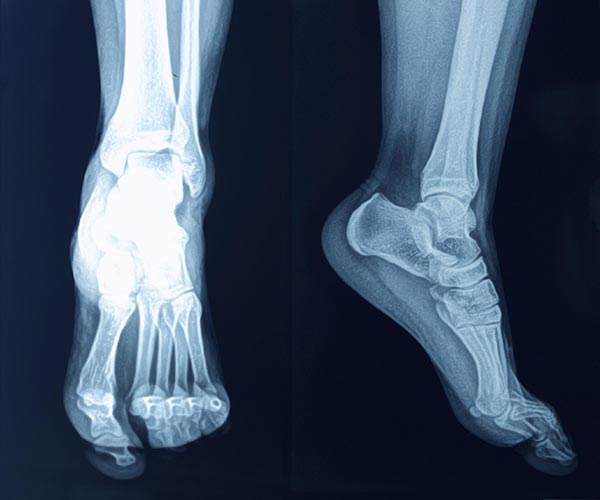Appointments: 702-966-1533 | Injury, Emergency, Trauma: 833-TXT-CHAN (833-898-2426)
Stress Fractures
A stress fracture is a crack in the bone, or severe bruising, that is caused by overuse. It is most common in the foot and ankle. The foot and ankle is amazing and is highly adapted to the stresses imposed by your body and lifestyle. It is strong enough to withstand your recent weight gain or your daily jogs or even hiking in the mountains. But when there is an abrupt change in your weight or lifestyle, the bones in the foot and ankle may not be able to adapt as fast and can sustain stress fractures.

Patients that train for marathons and increase their running distance, or a change in shoe wear (to something less shock absorbing), or even a change in training conditions (from a treadmill to outdoor pavement), can cause stress fractures. Another reason can be a change in bone density, such as in osteoporosis.
Diagnosis of Stress Fractures
Stress fractures occur most often in the second and third metatarsals in the foot, which typically have the highest impact pressure when you walk or run. They can also occur in the calcaneus (heel bone), fibula (outer bone of the ankle), or navicular (bone in midfoot). Stress fractures also occur more often in females, due to a higher risk of osteoporosis, or decrease in bone mass.
Poor conditioning, or doing too much too soon, is a common cause of a stress fracture. Patients try to start exercising again, picking up where they left off, instead of starting off slowly. The bones of the foot and ankle cannot adapt this quickly and can fracture. Improper technique and equipment is another cause. Any change in your mechanics of the foot and ankle to absorb impact can lead to injury. This is also true with a change in the surface on which a patient exercises or plays sports. More impact pressure on a harder ground surface leads to more risk of a stress fracture.
Patients with stress fractures, typically complain of acute pain that is worse with standing and walking but improves with sitting rest. Patients may also have bruising or swelling to the area of pain as well as tenderness to touch. If you suspect a stress fracture, using R.I.C.E (rest, ice, compression, elevation) will help with the pain and swelling, as well as use of anti-inflammatory drugs. Patients may even require special shoe wear or bracing to offload, or take pressure away, from the stress fracture. Diagnosis can be made by clinical and radiographic examination with x-ray. Sometimes a bone scan or MRI is required to pick up the stress fracture.
Treatment of Stress Fractures
Treatment of a stress fracture that has not displaced, or moved, is almost always conservative with cessation of the aggravating activity/exercise. Again, R.I.C.E should be used as well as pain and swelling control with anti-inflammatory medications. If more severe, an offloading shoe/brace or even cast, may be required to decrease the pressure and bending through the stress fracture. Follow up with your Primary Care Doctor or Orthopedic surgeon for bone density testing, if concerned, should be done. If the stress fracture has displaced, or moved, then surgery may be necessary. Once the fracture has healed, counselling and guidance by your Primary Care Doctor, Orthopedic surgeon, or physical therapist is recommended to allow a gradual return to activity to prevent refracture.

